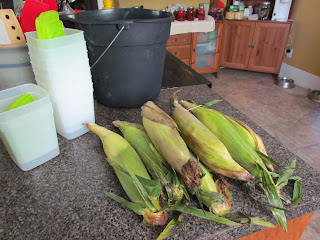Years ago, my mom tried freezing corn-on-the-cob without blanching and it worked just fine! In fact, we enjoyed the texture of it better than blanched corn that was frozen. The unblanched frozen corn (to us anyway) resembled the texture and taste of fresh corn more accurately than the blanched frozen corn did. From everything I've been able to read and question, unblanched frozen corn does not seem to pose a safety concern either.
There are 2 methods that I've used myself. The first is the absolute quickest and easiest. Take your sweet corn, wrap it in aluminum foil to completely cover it (WITH the shuck still on!) and throw it in the freezer! When you get ready to cook it, loosen one end of the foil and loosen the pointed tip of the shuck, run a little cool water into the end of the corn, then wrap the foil back up and place it on the grill to cook. OR you can take the foil off, loosen the pointed end of the shuck and run the cool water in, wrap the corn in a paper towel and cook it in the microwave for about 5 minutes. Be careful when you remove the shuck! It will be HOT and steamy!
The other method I've tried of freezing corn without blanching is a bit more time consuming (because I cut it off the cob), but it tastes just as good! Just shuck the corn, clean all the "hairs" off the corn, wash the cob in cool water, then cut the corn off the cob, spoon the corn kernels into a freezer container and freeze!
 |
| Corn-on-the-cob with it's shucks still on. |
 |
| The "hairs" that need to be removed from the corn before cutting it off the cob. |
If you've read my previous blogs, you'll remember that I have RA now (rheumatoid arthritis). It's harder for me to use my hands in a physical way. Cutting the corn off the cob is hard for me to do with just a knife. I started looking around and I found THE best device to cut the kernels off the corn cob! It's currently priced at $9.99 and comes from Carol Wright Gifts. I know, you're thinking it won't be sturdy (it is made of mostly plastic). Well, I've finished putting up our sweet corn this year and it held up just fine and is stored away now, waiting for use next season! Here's the link to the corn cutter's page (they call it a corn stripper):
http://www.carolwrightgifts.com/corn-stripper/80342.cfm?key=5G00236B&cm_mmc=PaidSearch-_-GooglePLA-_-FreeShip-_-80342&gclid=CJus7MXKh84CFdU6gQod6WEOAg
Here are some pictures of it. It's EASY to use, easy to clean, keeps the kernels from going all over the place and works for both uncooked AND cooked corn on the cob!
 |
| The corn cutter/stripper assembled and ready to use. |
 |
| Corn cob placed in the cylinder, getting ready to cut the corn off. |
 |
| Place the metal hollow "rod" over the end of the cob. |
 |
| You can see the cob sticking out the end of the metal "rod". By placing the yellow "tamper" into the end of the rod, you can force the cob out the other end. |
 |
| Left over cobs. You can see just a tad bit of corn left on the cob (at the small end). If you want to cut that off with a knife, you can. It doesn't leave very much on there though. |
We like to add red bell peppers to our sweet corn. You can do that now, before you freeze it, or you can add them in later when you cook the corn. Your choice and it works fine either way.
**Important Reminder!** If you save the cobs to feed to livestock later on (more than a day later), be sure to keep the cobs in the refrigerator. They can (and will) mold if left at room temperature for over a day. NEVER feed molded cobs to any livestock. It can make them sick.
**Another important reminder!** Never feed anything to someone else's animals, without their permission. Meaning, if you live next to livestock, do NOT just throw this stuff over the fence. You can make the animals very sick. Some of them can be allergic to certain foods, just like you are! ALWAYS ask the owner first, if it's OK to give something to their animals. PLEASE, YOU MUST ALWAYS ASK FIRST!!
That's it for this blog's helpful, time saving hints! Next blog will look at another new appliance I added to the food preserving line-up this summer, a sauce maker! I love it too! Until then, happy freezing and canning! (Next blog due out Monday August 15th.)




No comments:
Post a Comment